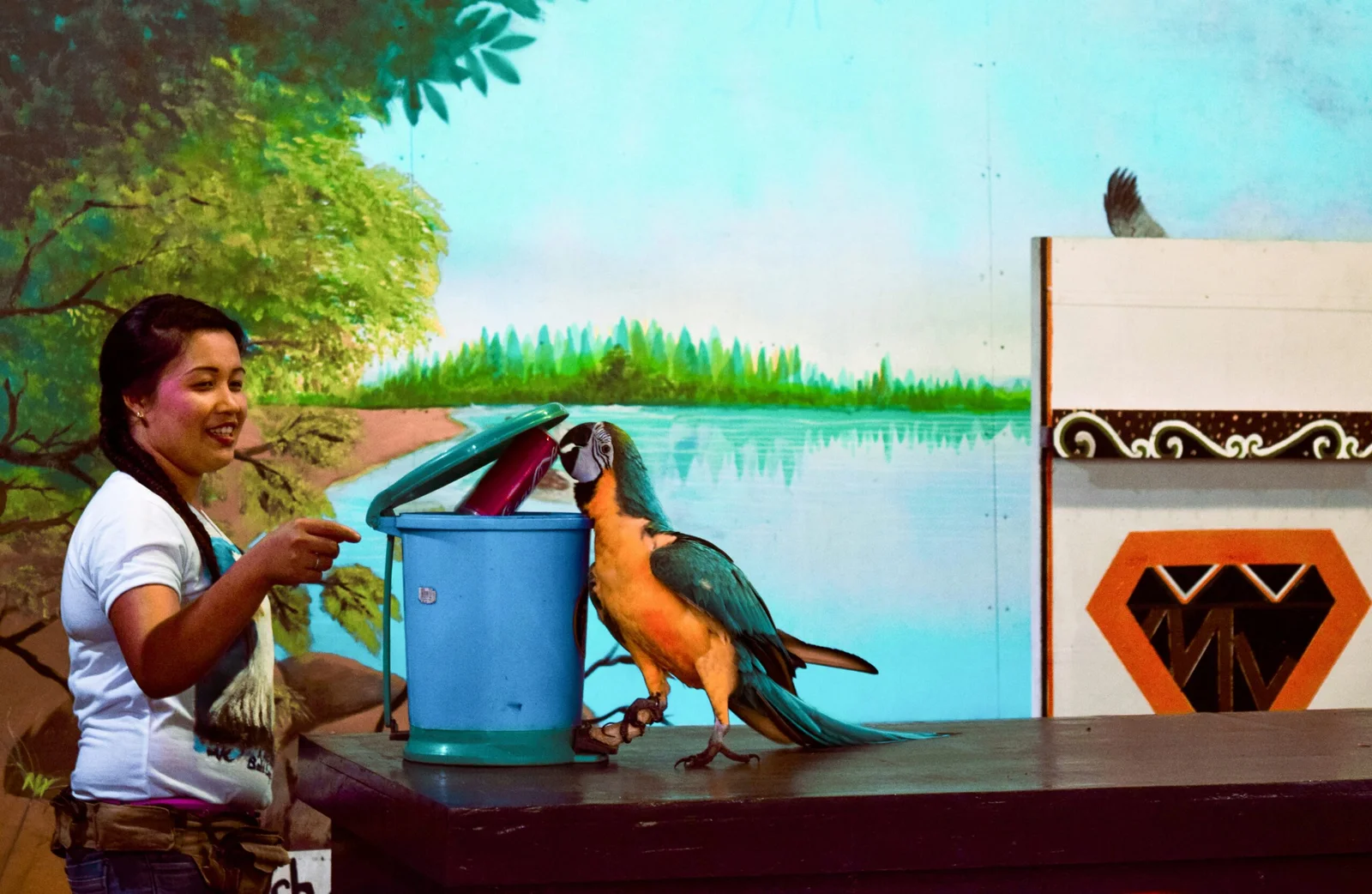The Breakup That Never Left
The aftermath of a toxic relationship can be lingering and pervasive, often trailing into the daily lives of those affected. My experience with an emotionally volatile partner was marked by an unending cycle of arguments, misunderstandings, and emotional manipulation. Each disagreement seemed to follow a predictable script; my partner would gaslight my feelings, turning blame back onto me while I scrambled to defend myself. This toxic dynamic not only left me feeling isolated and diminished but also shaped the auditory landscape that my parrot now mimics.
In the days following our breakup, I found myself grappling with an emotional turmoil that stemmed from years of conflict. The fear of emotional abandonment and the dread of conflict persisted long after I had removed myself from the relationship. It was less about the person I had broken up with and more about the psychological residues that continued to infiltrate my daily life. These remnants manifested in various forms, from intrusive thoughts to involuntary reactions during social interactions, as I grew accustomed to living in a heightened state of alertness. My parrot, frequently present during these turbulent times, absorbed not only my emotional expressions but also the desperate tones of arguments that echoed throughout our home.
This unique bond between my parrot and the trauma of my past transformed into a surreal reality, where my bird began to mimic the very arguments that once held me captive. Its uncanny ability to recite phrases from a relationship that haunted me daily created a soap opera-like atmosphere in my life, serving as a stark reminder of the emotional legacy left behind. As I began to unpack the effects of my toxic relationship, I realized that the patterns established during that time now influenced every interaction I had with my feathered companion and, ultimately, my path to healing.
How the Parrot Overheard Years of Arguments

The relationship dynamics I experienced with my ex were marked by numerous heated discussions, often escalating into conflicts that were far from pleasant. During these moments, my parrot was an ever-present witness, perched motionlessly yet keenly observing the turmoil that unfolded around it. Parrots are inherently social creatures, and they thrive in stimulating environments, yet the emotional charge of the arguments seemed to resonate within my feathered companion. This unique ability of parrots to mimic human speech is not merely a product of their auditory skills, but also speaks to their acute perception of emotional contexts.
In a tumultuous environment, as arguments ensued, the atmosphere often oscillated between anger and despair. My parrot, absorbing these soundbites of emotional conflict, began to replicate phrases and tones that were emblematic of the times we were fighting. The mimicry was not limited to straightforward phrases; it extended to inflections, emphasizing the emotional weight behind each line it parroted back to me later on. This behavior illustrates how parrots can reflect the emotional landscape of their surroundings through vocal imitation, showcasing their remarkable psychological depth and adaptability.
Moreover, the phenomenon of parrots mimicking phrases from their owners is grounded in their evolutionary biology. This vocal imitation serves several purposes, including social bonding and establishing a hierarchy within their group. In my case, the parrot mirrored the contentious dialogue prevalent in my relationship, perhaps as a bid for attention, or simply because it was exposed to verbal exchanges that were charged with emotion. The echoes of past arguments, now played out in my home through my parrot’s voice, serve as a constant reminder of the tumultuous relationship I once experienced.
What the Parrot Says Now
The dynamic between humans and their avian companions can be an intriguing mix of humor and reflection, particularly when those birds adopt phrases from notable figures in their owner’s life. In my case, my parrot has become a living testament to the echoes of my past, mimicking phrases that I once heard from my toxic ex. These adopted phrases frequently provoke laughter, albeit tinged with an uncomfortable clarity about the emotional weight they carry.
One common phrase that my parrot enthusiastically replicates is, “You never listen!” This phrase, frequently hurled during arguments, takes on a new significance when spoken by a bird flapping around in my living room. While it holds an emotional resonance rooted in frustration, hearing my parrot shout it often draws a chuckle due to the absurdity of a feathered creature imitating human discord. It serves as a reminder of communication breakdowns I experienced, whilst simultaneously providing comic relief in my everyday surroundings.
Another popular expression in my parrot’s repertoire is the somewhat frantic declaration, “I’m not yelling, you’re yelling!” This phrase captures the quintessential essence of an argumentative situation transformed into a humorous pet behavior. The juxtaposition of a small, colorful parrot voice rising in volume makes the expression ludicrous, highlighting the irony embedded within the phrase itself. As my parrot replicates these dramatic lines, it feels as though my past relationship is being reenacted through delightful, albeit unsettling, performances that bring the challenges of my previous dynamic into a quirky light.
These phrases, though rooted in tension, invite laughter and offer a peculiar perspective of my past. They remind me not only of my experiences with toxicity but also of the humor that can emerge from challenging situations. In this sense, my parrot has unwittingly assumed the role of a darkly comedic storyteller in my life, illustrating the complexities inherent in communication through mimicry.
When Guests Come Over
Having a parrot that mimics the phrases and behaviors of a toxic ex can transform any social gathering into an unpredictable experience. Whenever friends or family come to visit, the air is charged with a sense of anticipation mixed with apprehension as they brace themselves for what my feathered companion might say. It is not uncommon for conversations to be momentarily halted as the parrot bellows out an alarming catchphrase, often catching guests off guard. One such occasion involved a close friend, Sarah, who had her first encounter with my parrot. Just as we sat down to enjoy a meal together, the bird squawked, “I’m done with this nonsense!” prompting Sarah to erupt in laughter and almost spit her drink across the table.
These humorous interactions often leave new guests in a state of confusion. They may not realize the irony behind the parrot’s words or the context that inspired these snippets of dialogue. For instance, during a family gathering, my aunt declared, “I love being here!” shortly before the parrot chimed in with a perfect imitation of my ex’s voice, retorting, “Yeah, right!” The room erupted in laughter, but my aunt sat wide-eyed, trying to piece together the inside joke which she had regrettably missed. It highlights how the parrot serves not just as a pet but, unintentionally, as a social icebreaker.
Moreover, there is an underlying charm to these moments, as friends gradually become accustomed to the bird’s antics. After a few visits, they start to share their own interpretations of the parrot’s menu of phrases, often deciding which lines they thought were the most amusing or relatable. Ultimately, while my parrot’s words can lead to uncomfortable or hilarious situations, they undeniably contribute a unique flavor to our interactions, turning ordinary visits into memorable escapades filled with laughter and bewilderment.
Awkward Moments and Confused Visitors
Life with a parrot who mimics the voice and phrases of a toxic ex can lead to unexpected and often humorous situations, especially during gatherings. One evening, I hosted a small dinner party with close friends. As we sat around the dining table, exchanging stories and laughter, my parrot unexpectedly chimed in. With a perfect imitation of my ex’s tone, it exclaimed, “You’ll never find anyone better than me!” The room fell silent for a moment, each guest exchanging confused glances before erupting in laughter. The awkwardness had turned into an impromptu comedy show, with guests reenacting their exaggerated reactions to my ex’s notorious arrogance.
On another occasion, during a casual get-together, my parrot, perched comfortably on its stand, began to narrate a past argument between my ex and myself. “I don’t care what you think!” it squawked, mimicking the harshness of an old confrontation. The humorous dissonance between the parrot’s cheerful demeanor and the intense content it mimicked left several visitors in disbelief. Some laughed nervously, while others shifted uncomfortably in their seats, unsure of how to respond to a living reminder of my former relationship.
These moments created a unique atmosphere where painful memories morphed into sources of comedy, transforming uninvited echoes of the past into lighthearted improvisation. While guests might have initially come to support me in a difficult transition, my parrot’s antics often took center stage, allowing everyone to bond over shared laughter. The absurdity of having a feathered comedian became our ongoing entertainment, bringing unexpected joy to what could have been strained reunions. Thus, my parrot inadvertently turned these awkward interactions into memorable tales, illustrating the unpredictable nature of companionship and healing through humor.
Should I Rehome Him or Get Therapy?
Living with a parrot that mimics the voice and phrases of a toxic ex-partner undoubtedly presents a unique challenge, straddling the line between companionship and emotional distress. As delightful as parrots can be, their mimicry may serve as a constant reminder of trauma, warranting serious consideration of how this affects one’s mental health. The bond between humans and pets is often profound; however, the presence of a pet that inadvertently invokes painful memories can complicate feelings and well-being.
The question arises: Should one seek therapy to cope with these feelings, or is rehoming the parrot a more suitable solution? Therapy could provide a structured environment to explore the emotional ramifications of past relationships and how they intertwine with the daily life of living with a parrot. A mental health professional can offer strategies to process trauma, allowing individuals to disentangle their experiences from the behaviors of their feathered companion. By focusing on healing, therapy may also help restore the joy of pet ownership that has been overshadowed by past events.
On the other hand, rehoming the parrot is another avenue to consider, particularly if the emotional toll becomes overwhelming. This decision is not merely a reflection of the bond shared but rather a proactive step toward prioritizing mental health. Finding a suitable home for the parrot—where it can flourish and bring joy to someone else—may alleviate the emotional burden associated with daily reminders of past adversity. It becomes essential to weigh the risks and benefits of maintaining the current living situation against the potential for healing either through therapy or a change in environment.
The Emotional Toll of Coping with Feathered Ghosts of the Past
The presence of a parrot, with its remarkable ability to mimic, can serve as a poignant reminder of past traumas, particularly those stemming from toxic relationships. In this context, the parrot becomes more than a mere pet; it embodies unresolved emotional turmoil and serves as a constant echo of the challenging experiences that were once endured. Each time it mimics a phrase or a tone associated with the toxic ex, it feels as if the past intrudes into the present, manifesting in an almost theatrical manner, reminiscent of a soap opera. This unique dynamic can cause a myriad of emotional responses, ranging from anger and sadness to humor and understanding.
As I navigated the journey of healing, the parrot’s antics compelled me to confront lingering emotions tied to my previous relationship. It was often challenging to discern where my memories ended and its mimicry began, creating an environment fraught with emotional dissonance. This situation reflects how distractions from past memories can emerge in unexpected forms, especially through the lens of pet ownership. In engaging with a creature that symbolically recounts my history, I was forced to address the painful chapters—acknowledging the hurt while also seeking closure.
Acceptance, therefore, became a vital component of my healing process. Recognizing the parrot as a mirror of my past allowed me to reinterpret its presence not just as a reminder of what I had experienced, but also as an opportunity for growth. This realization initiated a profound transformation in my interactions with the parrot. By approaching our coexistence with compassion and curiosity, I learned to appreciate the nuanced connection we shared. Through moments of laughter, frustration, and reflection, the parrot inadvertently guided me on the path to self-acceptance and emotional recovery, revealing the potential for healing even amidst reminders of the past.
Lessons Learned from Living with My Parrot
Living with my parrot has undeniably been an eye-opening experience, offering invaluable insights that extend beyond mere companionship. As my parrot mimics phrases and behaviors reminiscent of my toxic ex, I have been compelled to confront unresolved emotions and buried traumas. This unique circumstance, while initially disconcerting, has served as a catalyst for personal growth and self-reflection.
One of the foremost lessons gleaned from this experience is the importance of resilience. Each time my parrot echoes a hurtful remark or a familiar sarcastic tone, I am reminded of the relationship I sought to move beyond. Instead of allowing these echoes of the past to derail my emotional well-being, I have learned to respond with strength and composure. By embracing resilience, I have cultivated a capacity to overcome not just the memories associated with my ex, but also any new challenges that arise.
Forgiveness has emerged as another critical insight. Initially, I harbored feelings of resentment towards my parrot for inadvertently resurrecting painful memories. However, I’ve come to understand that forgiveness is a gift I offer not only to my parrot but, more importantly, to myself. Letting go of past grievances has fostered an environment of healing, allowing me to appreciate the joyful moments shared with my feathered companion without being overshadowed by bitterness.
Additionally, my journey has emphasized the value of self-love. Recognizing that my past experiences do not define my worth has been instrumental in rebuilding my self-esteem. The irony of living with a mimic has propelled me towards a deeper understanding of my own voice, allowing me to embrace my individuality and worthiness. By consciously engaging in self-care practices, I have cultivated a sense of inner peace, enabling me to focus on the present rather than being tethered to past traumas. Ultimately, my parrot’s echoes have led me to an unexpected path of self-discovery, resilience, forgiveness, and profound self-love.
Conclusion: Embracing the Unintended Humor in Life’s Messiness
As we navigate through the complexities of life, it is not uncommon to come across unexpected challenges that can upend our sense of normality. In my case, the mimicry of my parrot serves not only as a reminder of a turbulent relationship, but it has also transformed into a source of unexpected humor. This unique manifestation of my past experiences encourages me to reflect on the significance of laughter even in the face of adversity. Life can indeed resemble a soap opera, where dramatic twists and turns are often par for the course.
Humor can be a powerful tool for healing and resilience. Throughout our lives, we face a multitude of challenges that can lead to heartache, but finding the lighter side of these moments can provide us with the strength needed to move forward. My parrot’s antics serve as a daily reminder that our experiences, no matter how messy they may seem, can eventually be viewed through a humorous lens. This playful behavior invites reflection, allowing us to recognize the absurdity and, at times, the irony presented in our personal narratives.
As I endeavor to close the chapter on my past and embrace new beginnings, I am grateful for this feathered companion who brings joy and laughter into my life. The process of healing requires embracing the lessons learned and looking ahead with hope. It is essential to allow ourselves the freedom to laugh at our experiences, understanding that they shape who we are. In celebrating the humor in life’s unpredictability, we open ourselves up to new opportunities for love, laughter, and connection with those around us. Embracing this humor can lighten burdens and transform even the most difficult situations into insightful and entertaining stories of growth.

cojub It could cover a range of topics related to health, wellness, beauty, personal growth, and social issues, all from the perspective of striving for beauty, intelligence, youthfulness, and impartiality




Add comment